Moko Kauae Worn with Mana
Dec 18, 2018

In 2012 TE KARAKA published “Tā Moko Rising”, an article exploring the resurgence of traditional Māori facial art and celebrating nine Ngāi Tahu wāhine who had chosen to embrace this near-lost custom. Six years later, it is clear that this revitalisation has gained momentum, as more and more people choose to receive moko kauae and moko kanohi. In September, 15 wāhine Māori took part in a mokopapa wānanga at Rehua Marae, and now wear moko kauae proudly on their chin, an indelible representation of their whakapapa and identity. Nā Anna Brankin.
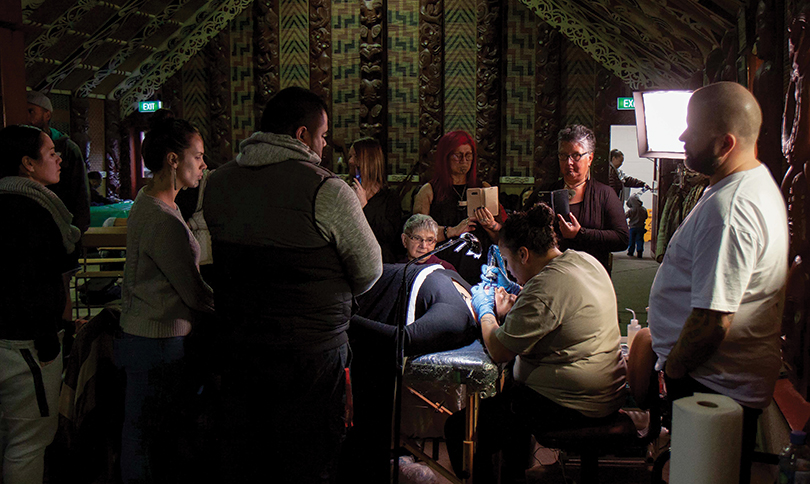
Above: Whānau watch on as Ana Fa’au receives her moko.
The wharenui at Rehua Marae in Ōtautahi is packed with people, voices uplifted in waiata. They’re gathered around Waipounamu Te Karu (Ngāi Tahu – Ngāi Tūāhuriri), surrounding her with aroha as she lies prone on the tattoo bed, ready for a long-awaited moko kauae to be etched into her skin. Her immediate whānau sit alongside her, their hands touching whatever part of her they can reach – her hands, her feet, her knees. Portraits of her late grandparents watch over her as she undertakes this journey in honour of their memory and the values and culture they imparted to her.
Forty-five minutes later the process is complete. Waipounamu sits up and tears stream down her face as the enormity of the moment overwhelms her, and her whānau line up to embrace her and examine the taonga that now adorns her face.
“I had always wanted to get it done, but I thought it would happen when I was a taua – maybe when my first mokopuna was born,” Waipounamu reflects. “But when I heard about a mokopapa wānanga happening in the North Island, I told myself that if it ever came to Te Waipounamu I would definitely be a part of it.”
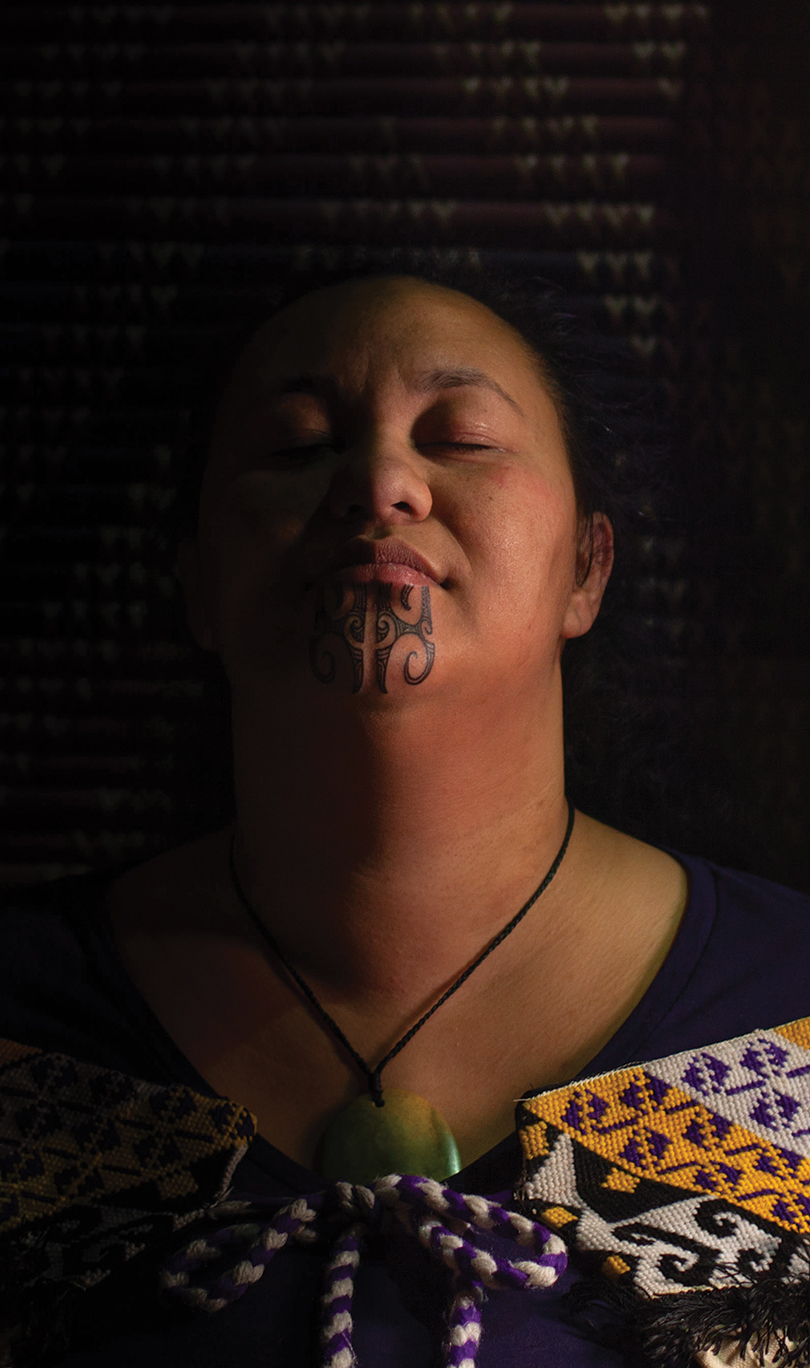
Above: Waipounamu Te Karu photographed immediately after receiving her moko kauae.
When she heard that tā moko artist Anikaaro Harawira-Havili (Te Aupōuri, Te Rarawa, Ngāpuhi) had offered to visit Ōtautahi and share her art with local wāhine, Waipounamu hesitated for only a moment. “Funnily enough, it was actually my tāne Davide Pangrazzi – who’s Italian – who said to me, ‘What’s there to think about? Just do it!’”
Davide has been passionate about te ao Māori since he first moved to Aotearoa and met Waipounamu, and has been a constant source of support and encouragement. “I think it’s because our cultures have so much in common,” she says. “They’re both very family-oriented, with strong beliefs and customs – very rich and vibrant. He loves everything to do with te ao Māori – everything.”
This respect for one another’s culture is important because Waipounamu and Davide are determined to create a diverse, multi-cultural environment for their tamariki – their son Aoraki Leonardo is three years old, and their second child is due early next year. “My son speaks only te reo Māori and Italian; and now he will grow up seeing my moko,” she says. “And any other babies we might have won’t know anything different. I hope that it will normalise it and perhaps encourage them to get their own one day.”
After receiving her moko kauae, Waipounamu was able to watch a video recording of the session – an experience she says was extraordinarily moving. “At the time, I had my eyes closed and was quite unaware of what was happening around me,” she says. “But watching it back, I could see how my tāne and my son reacted as they watched me. I cried when I saw how proud and emotional Davide looked, especially when he was close to tears himself. And my son just sat in his lap watching me quite calmly and curiously.”
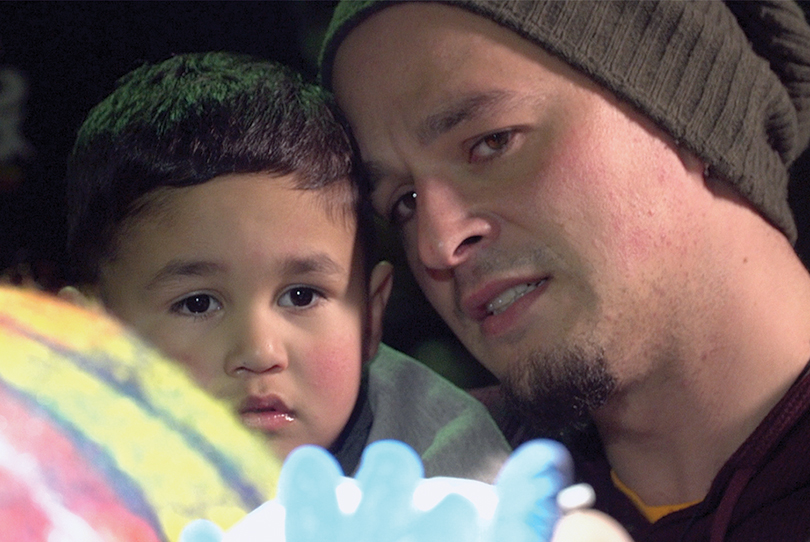
Above: Davide Pangrazzi with son Aoraki Leonardo as they watch Waipounamu receive her moko kauae.
The desire to normalise moko kauae for future generations was a motivation for a number of the wāhine who participated in the wānanga, including Moana-o-Hinerangi (Ngāi Tahu – Ōraka Aparima, Moeraki) and her two daughters, Miriama Buchanan and Ana Fa’aū. They received their moko kauae in consecutive sessions on the second morning of the wānanga, a circumstance that was as inevitable as it was fitting.
“There was never any question of one of us doing it without the others,” Ana says. “Not only will my kids grow up with a mum wearing her moko kauae, it’s also important for them to know that we all got it together. We move together – we are one and we act as one. We’re not individuals, we’re a collective. That’s important to me, and that’s what I hope they take away from this experience.”
The three wāhine decided to receive their moko kauae after Miriama completed the Mauri Ora Residential Rehabilitation Programme through He Waka Tapu earlier this year. “While I was in the whare, I had a couple of experiences that began to reconnect me to te ao Māori, and the thought of wearing one popped into my head,” she says. “After completing the programme and stepping into a sober and clean life, I discussed it with my sister. But at that stage I thought I would have to wait until I was fluent in te reo, or had achieved 15 years of sobriety or something.”
Ana disagreed, reminding her sister that moko kauae is an expression of whakapapa and identity that is the birth right of all wāhine Māori. “My sister’s reconnection to te ao Māori felt like the missing link in our whānau had made the choice to return,” Ana says. “And it felt like the right time. This journey is the outward representation of the inward transformation.
“It’s no coincidence that Miri is a wahine Māori and has had an experience of alcoholism and drug addiction,” she continues. “If there are survivors, if there are women to stand strong and tell stories of triumphs and overcoming adversity, then it’s us – it’s wāhine Māori. We now have to reclaim our identity and stand in our mana with the support and protection of our tīpuna and our atua.”
Moana nods in agreement. “The fact that our tīpuna were with us through this process was not only satisfying but necessary,” she says. “They haven’t failed me so far, so I didn’t expect them not to turn up today.”
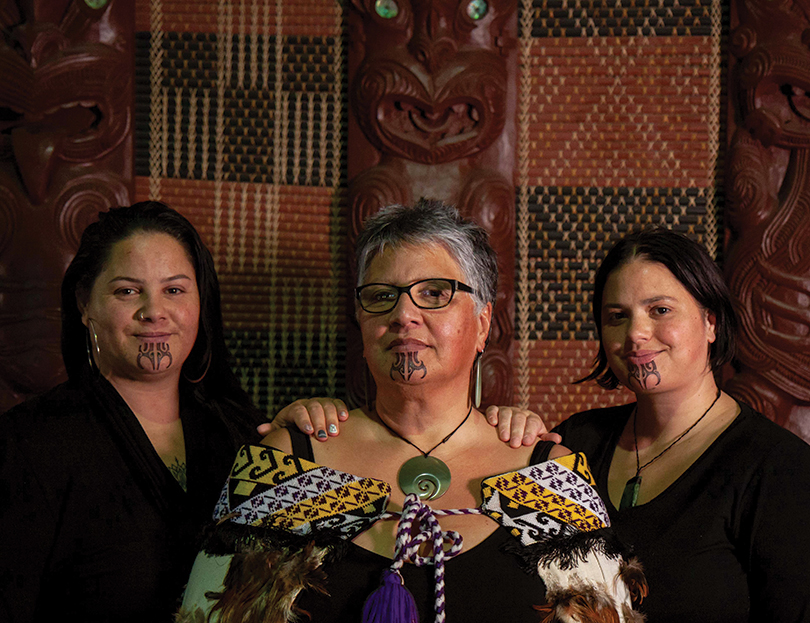
Above: Moana-o-Hinerangi flanked by her daughters Miriama Buchanan (right) and Ana Fa’aū.
These wāhine are certainly not alone in calling on their tīpuna to support and guide them through the painful process of having their identity inked into their skin — an experience that Moana likens to childbirth. “You might think I’m comparing the pain of each experience, but actually it’s about the fact that you come out with such a taonga at the end,” she laughs. “You take the pain because you know what’s coming, and you know it’s worth it.”
Miriama was struck by how quickly she adjusted to seeing her mother and sister with moko kauae. “When they sat up on the table, nothing looked any different,” she says. “They just looked like themselves – like Anikaaro had just uncovered something that was already there.”
“It (kauae) is the art form that was in the greatest danger of dying out. The only ones who were keeping it alive were the gangsters and the mobsters, and not in a nice way. For a while there I was on my own.”
Hana Morgan
Ngāi Tahu, Ngāti Māmoe, Waitaha, Te Arawa, Ngāi te Rangi, Ngāti Awa
Tohunga tā moko Anikaaro agrees wholeheartedly with this sentiment. “My job isn’t to put something on the face – it’s to bring forth what is already there,” she says. “People don’t get it and then expect a change – the change happens prior, and the moko kauae is a statement: ‘This is who I am now, this is how I’m going to move forward in life.’”
Anikaaro learned the art of tā moko at Toihoukura under the tutelage of renowned tohunga Derek Lardelli. “I saw the abundance of kauae in Ngāti Porou and felt aroha for my people back home who didn’t really carry it,” she says. “The biggest thing for me was to embrace it and take it home to my people – to let them acknowledge it as a taonga. Since then it’s brought me on journeys throughout Aotearoa, such as this one to Ōtautahi. I’m glad to be a part of the revival of kauae, which has been years in the making now.”
Hana Morgan (Ngāi Tahu, Ngāti Māmoe, Waitaha, Te Arawa, Ngāi te Rangi, Ngāti Awa) has been a part of this revival since receiving her moko kauae 12 years ago.
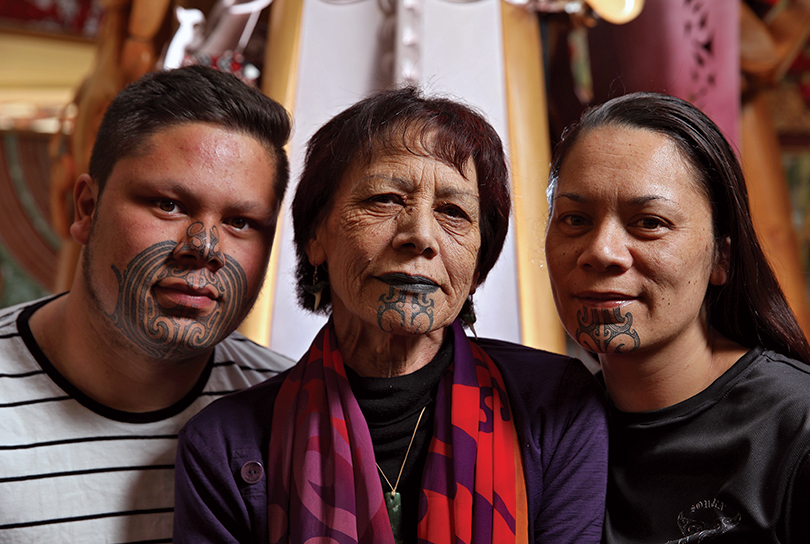
Above: Hana Morgan with her mokopuna Thomas (left) and daughter Mali (right) as they celebrate their intergenerational taonga.
“It is the art form that was in the greatest danger of dying out. The only ones who were keeping it alive were the gangsters and the mobsters, and not in a nice way,” she says. “For a while there I was on my own.”
Hana has been heartened to see more and more people wearing moko over the last few years, and was especially proud when her daughter Mali and mokopuna Thomas chose to get their moko kauae and mataora moko this year.
“That was absolutely wonderful,” she says. “It was very emotional. Thomas sat beside me and held my hand all day when I got mine, and now he has had both lots of grandparents sitting beside him.”
Despite her happiness at seeing this art form continued, Hana cautions anyone thinking of getting their moko kauae to make sure they are doing so for the right reasons. “They’re not your run-of-the-mill tattoos,” she says. “They’re pieces of our history and our whakapapa – they’re expressions of ourselves.
“How much more visible could you be, eh?” she asks, gesturing to the intricate pattern that adorns her chin. “If you’re going to wear it well, you should be connected to te ao Māori somehow. But you hear all sorts of talk about saying you have to have the reo, or have to have done this or that. At the end of the day it’s up to the person and their whānau.”
Waipounamu agrees, saying that she has spoken to a number of wāhine who feel they are not yet worthy to receive their moko kauae – a feeling she believes is completely unfounded. “As far as I’m concerned, it’s a birth right. No one can tell you you’re not good enough or not ready to get it,” she says. “I say to them, ‘You were born to have this. It doesn’t mean you have to, but you always have the choice. And it’s more than a choice – it’s your right as wāhine Māori.’”